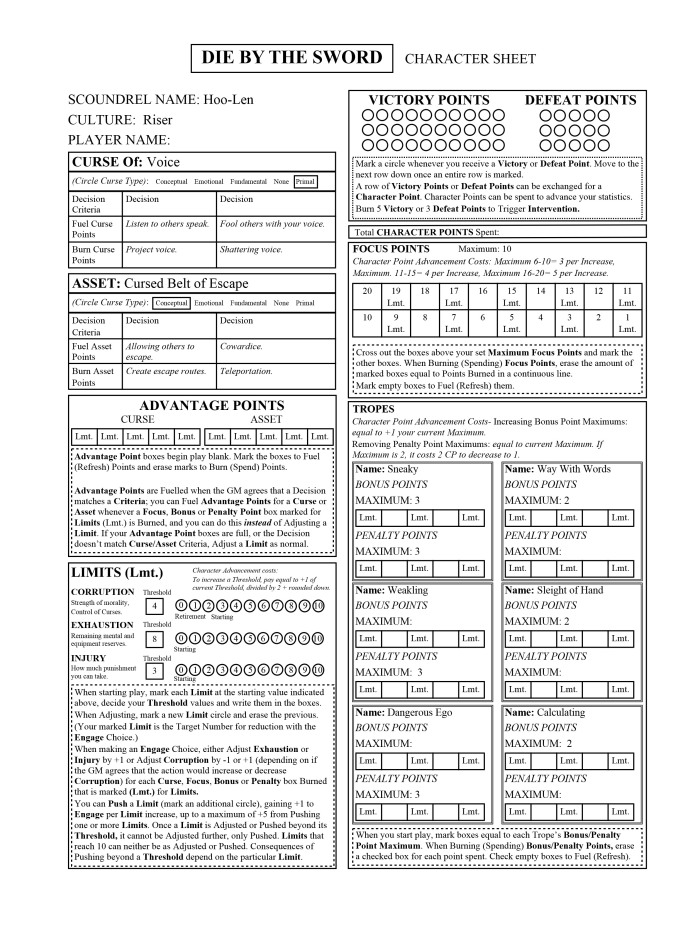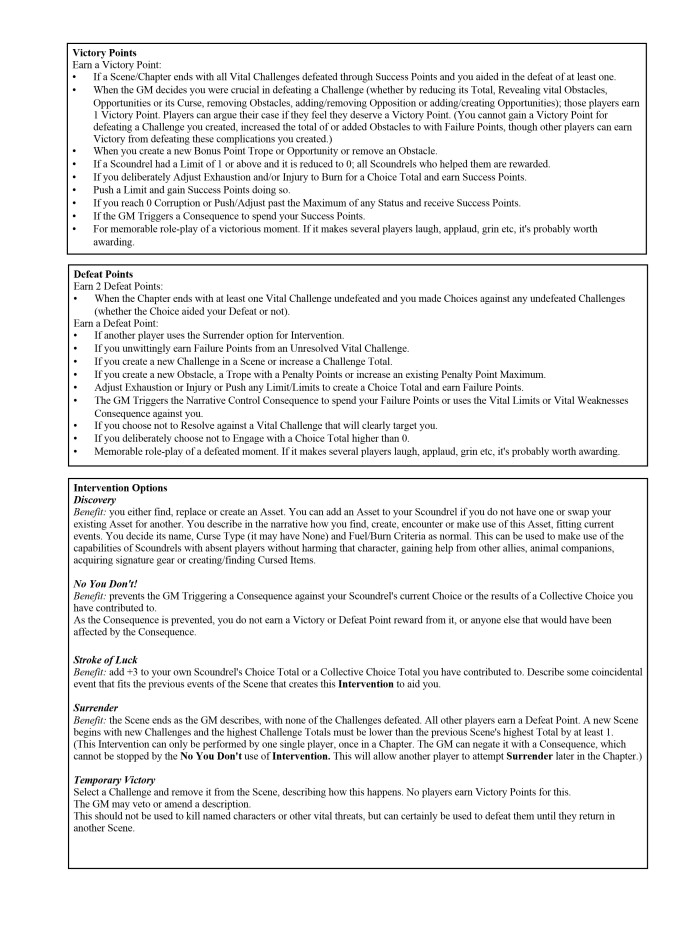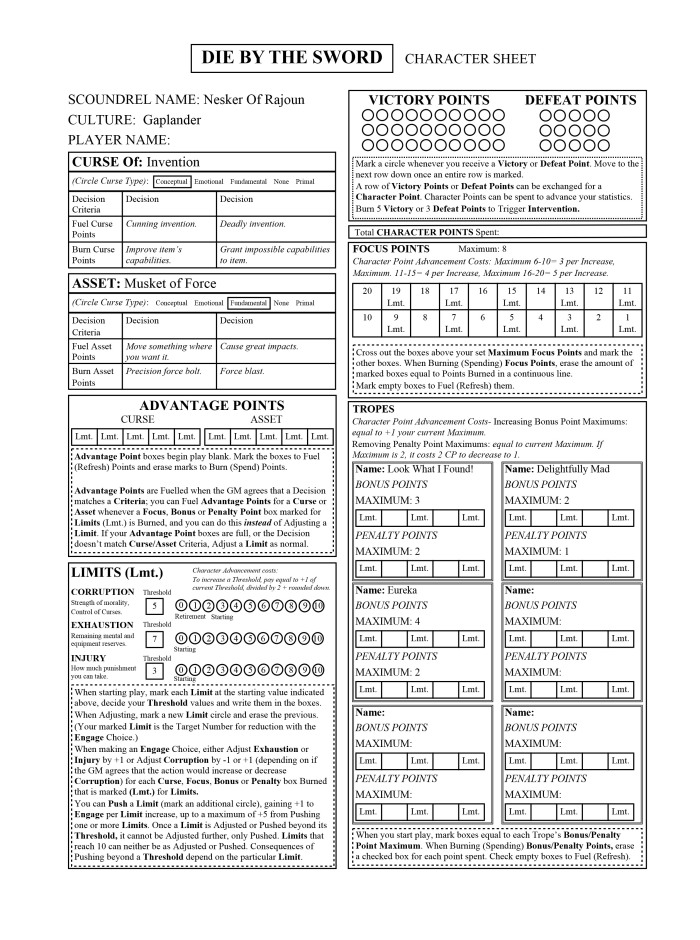Before continuing with this blog, make sure you’ve read the previous for the first part of the game-play example.
Introducing Challenges
About to hit Phase 2, and with the Scene firmly set, the GM introduces the Challenges.
As there are three players in this example, the GM can either create 1 Vital Challenge per player at Totals of 1 to 3, or two Vital Challenges, one at 1-3, the other at 4-5.
The GM decides that the armoured Mercenaries are clearly a massive and direct issue, and will be more competent than trained soldiers, so they set them to a Total of 4.
Any aggression will also cause a wider Bar Fight. There’s not likely to be much skill displayed or individual danger demonstrated by the punters, but due to the general chaos, the GM sets a Bar Fight Challenge Total at 3 (5 is the highest possible total, so 3 is a moderate threat).
There can also be an Additional Challenge of 1-3 per 2 players or 4-5 per 3 players.
They decide that Bar Furniture suits; you could trip on it, be clubbed by it, but also use it as a weapon, to hide etc. As the GM has 3 players, they set the Total to 4.
Each Challenge will have at least one Obstacle (player descriptions involving this phrase can Trigger Choice Penalty of at least -1) and Opportunity (descriptions can Trigger Bonuses instead). These begin as Hidden and are secretly decided and written down by the GM. These can be Revealed either through role-play that the GM feels makes Obstacles/Opportunities obvious, through guesses from the players or through use of Success Points.
Challenges may also have an Opposition, relating to another Challenge, where if the Totals are different, the difference may create Bonuses or Penalties as the Challenge dictates.
The GM reveals that Bar Furniture has Opposition to Bar Fight, and with 4 vs 3, anyone contending with the Bar Fight in a manner that puts them in danger of Bar Furniture will receive a -1 to their Choice. However, if Bar Furniture’s Total is reduced below Bar Fight, then Choice Bonuses may occur.
Opposition can also be created with Success and Failure Points.
Phase 2
As Ter-Saa refuses to drop the empty bottle, one of the two mercenaries that have approached the table (there are two more watching) moves in to take it.

Ter-Saa uses their other hand to grab the reaching arm, describes creating an arm lock. The GM describes the sudden movement throwing off the Mercenary’s balance, and Triggers the Challenge’s Hidden Opportunity: Drunk. They tell the player that they have Triggered an Opportunity, but not what it is (though their description should give a clue).
(Decision: Ter-Saa spends 2 Focus Points, gets a +1 Bonus from the Opp, for a Choice Total of 3 vs 4. For their Limit Adjustment, they Fuel 1 Curse Point for “impose weight on others).
The GM describes the Mercenary shoving Ter-Saa against the wall, and Triggers one of their Berserker Trope Penalty Points, as their control begins to turn into fury.
(Choice Total: 2. Limit Adjustment: Exhaustion increased to 1, as they are winded.)
There is a cry of ‘FIGHT!’ in the background. The person who yells it is punched in the face. Chaos erupts in the background.
Now, Choice Totals, via repeat Decisions, can continue to build and decline until the player decides to Resolve their Choice with either Success Points, Failure Points or Stalemate. This requires the player deciding when they have Burned enough points or when they cannot afford to Adjust any more Limits, and when to accept the fate of their Choice.
The GM can cut to other players to start making Decisions before other Choices are Resolved, as situations change in the Scene. Players can either make a separate Choice to deal with the same or different Challenges as other players (starting at 0) or a Collective Choice, adding their Decisions to that of other players.
Currently, Ter-Saa is tackling the Mercenaries Challenge; another player could Engage the Challenge by descriptively dealing with any of the Mercenaries, not necessarily the one Ter-Saa is fighting.
Hoo-Len approaches the other Mercenary that approached their table and tussling their hair, speaking in a softly softly manner, asks very nicely if they wouldn’t mind pulling their friend off of her bodyguard. She Burns her second Way with Words Bonus Point, and 2 Focus, to bump the collective Choice Total to 5. With one Limit Adjustment, she Fuels 1 more Curse Point for the Decision Criteria of “fool others with your voice.” The one merc, clearly immensely enamoured and stuttering a little, tries to pull their ally off of Ter-Saa.

The players decide to Resolve there, getting 1 Success Point. Hoo-Len decides to use it to create a Temporary Ally Opportunity to make Mercenaries to fight. (Earning 1 Victory Point to make the story more interesting with an Opportunity, rather than reducing the Challenge Total.) They also accurately guess that the Mercenaries are also Drunk, so the GM reveals this Opportunity; with the right description, any ally can Trigger a free +2 Bonus in the next Phase.
As Ter-Saa helped create a Success Point and Exhausted themselves to do it, they earn a Victory Point. Victory Points can be saved (along with Defeat Points) and traded to enhance character stats between chapters, or spent when you have 5 of them (or 3 Defeat Points) for Intervention, dramatic help when you really need it.

Bar Fight is a Vital Challenge. This means that if Nesker does not Engage it, there will likely be severe negative consequences at the end of the Phase.
The GM describes objects flying at the originators of the Bar Fight; this means Nesker is Engaging both Bar Fight and Bar Furniture and up against Furniture’s higher Challenge Total of 4, and receiving a -1 Penalty for Opposition.

Nesker flips the table over and dives behind it. With his description, he Triggers both the Hidden Opportunities of Bar Furniture and Bar Fight (Stay Put and Take Cover); this would give a free +2, but due to Opposition, goes down to +1.
He spends a Point of Focus and a Bonus Point from Eureka, for a Decision of 3 vs 4.
With 2 Limit Adjustments, he Fuels 2 Curse Points for “cunning invention.”
The GM describes the glass of thrown bottles shattering dangerously near him.
Nesker’s player describes starting picking up the hands with his glass and madly throwing it, Burning both of his Delightfully Mad Bonus Points. For his Limit Adjustment, he decides to increase Injury to 1, due to cutting his hands. (Player can decide Limit Adjustments, but the GM has right of veto, if they are deemed to be inappropriate.) This Decision increases his Total of 3 to 5.
With 1 Success Point, Nesker reduces Bar Furniture from 4 to 3, as some of the weapons are getting broken, and the players have a shield to get behind. This has an added benefit of matching the Bar Fight and Bar Furniture Challenges Total, so Opposition is at 0.
He earns one Victory Point for choosing to increasing Injury and earning a Success Point for that Choice.
Every player has made their Choice, all Vital Challenges are Resolved, so onto the next Phase.


 Delving a Little Deeper
Delving a Little Deeper